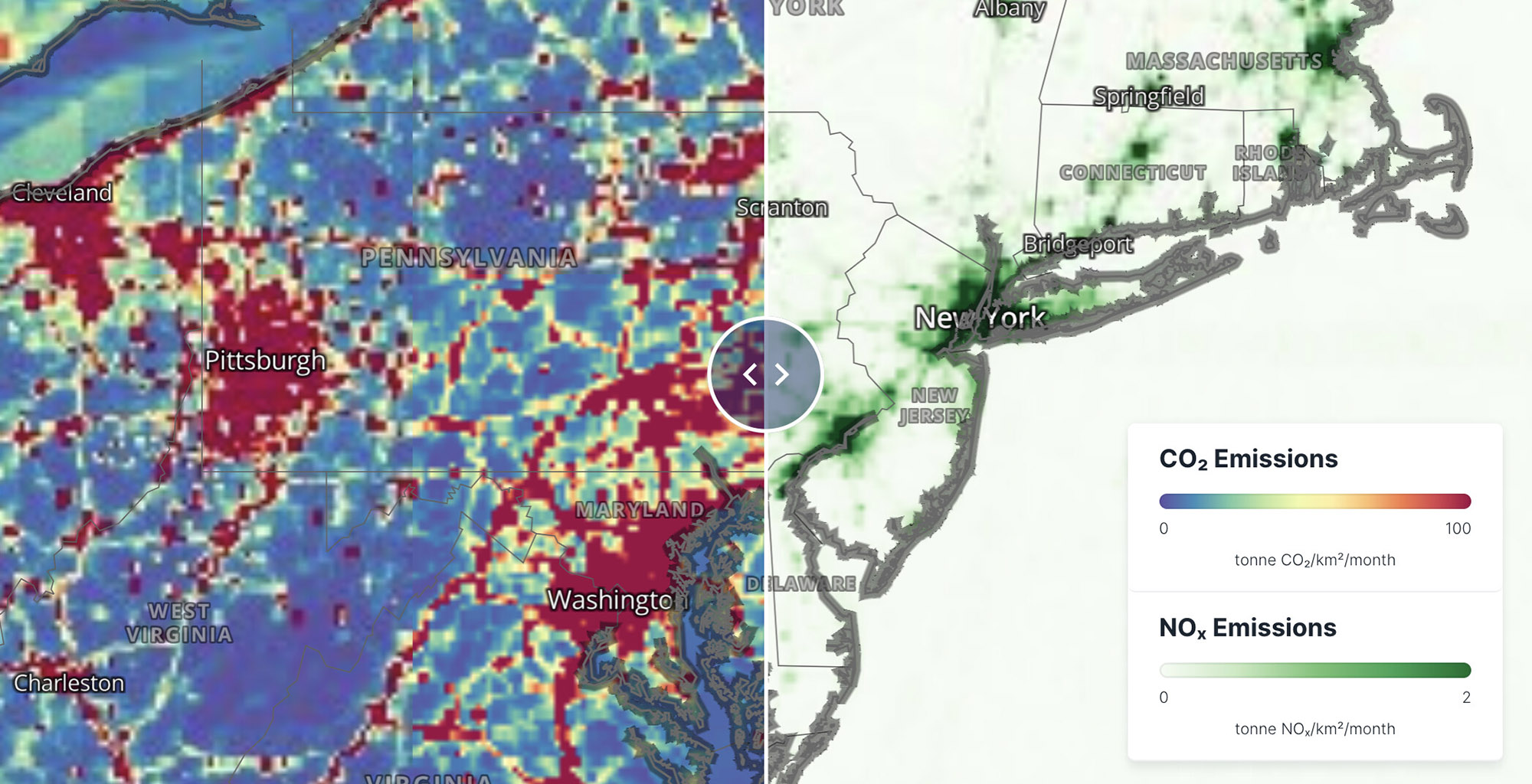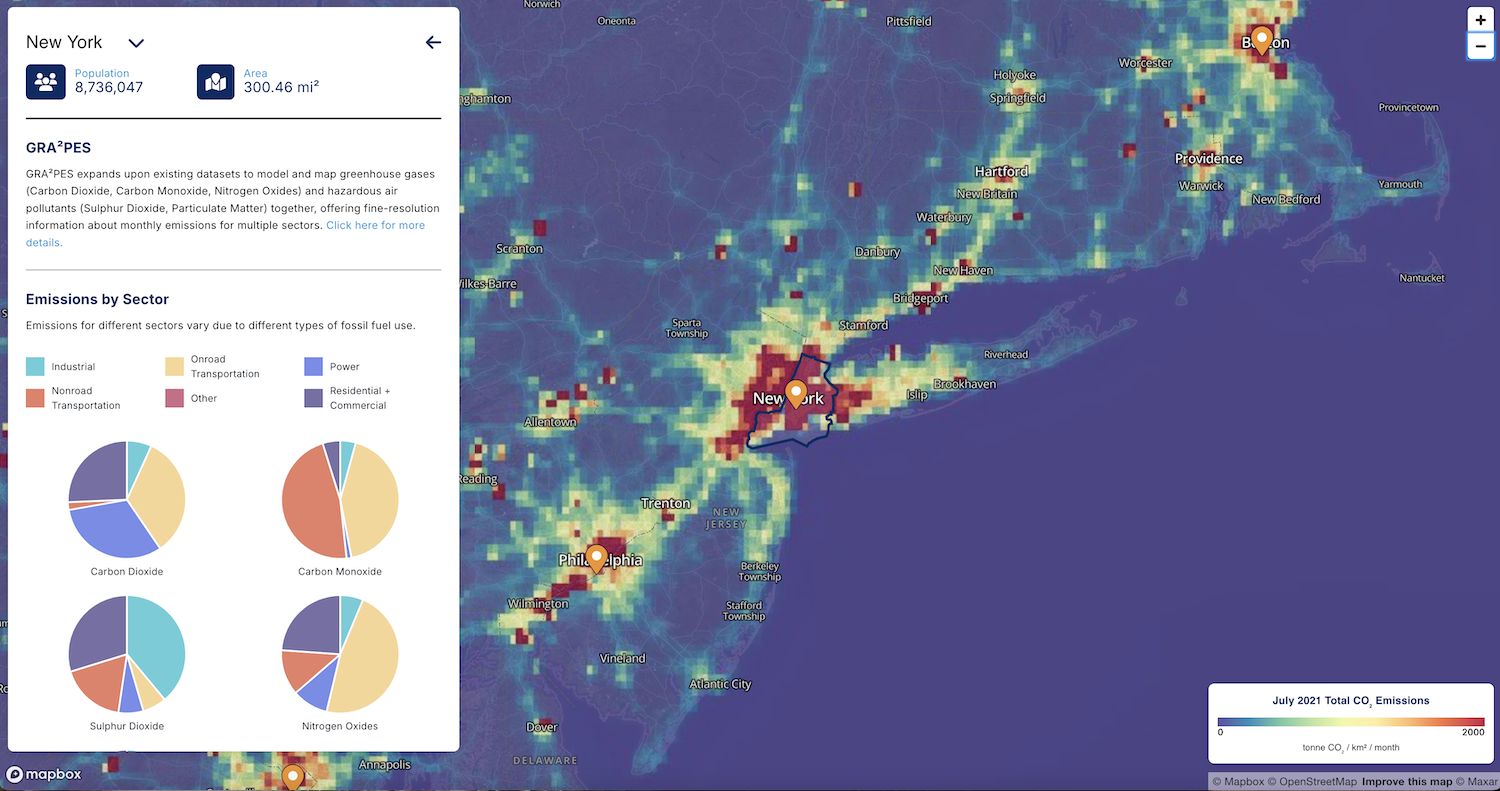A .gov website belongs to an official government organization in the United States.
A lock () or https:// means you've safely connected to the .gov website. Share sensitive information only on official, secure websites.
25 September 2024 The GReenhouse gas And Air Pollutants Emissions System (GRA2PES), from NOAA and NIST, combines information on greenhouse gas and air quality pollutant sources into a single national database, offering innovative interactive map displays and new benefits for both climate and public health solutions. A new U.S.-based system to combine air quality and greenhouse gas pollution sources into a single national research database is now available in the U.S. Greenhouse Gas Center portal. This geospatial data allows leaders at city, state, and regional scales to more easily identify and take steps to address air quality issues while reducing climate-related hazards for populations. The dataset is the GReenhouse gas And Air Pollutants Emissions System (GRA2PES). A research project developed by NOAA and NIST, GRA2PES captures monthly greenhouse gas (GHG) emissions activity for multiple economic sectors to improve measurement and modeling for both GHG and air pollutants across the contiguous U.S. Having the GHG and air quality constituents in the same dataset is be exceedingly helpful, said Columbia University atmospheric scientist Roisin Commane, the lead on a New York City project to improve emissions estimates. "My work focuses on emissions from the burning of fossil fuels to fingerprint the sources of greenhouse gases," Commane said. "But, at the moment, we have to use a mish-mash of datasets and we spend way too much time trying to figure out their different ways of representing things." Since the establishment of the U.S. Clean Air Act in 1970, environmental managers have made great strides in addressing primary causes of air pollution by focusing on single point sources like smokestacks, and wider diffused sources, known as non-point sources, like transportation sector emissions. Then at the start of the 21st century, the U.S. began establishing targets for reducing greenhouse gas emissions to address the root cause of climate change – again with a focus on smokestack and tailpipe pollution. Earth's atmosphere, however, doesn't distinguish between sources. Greenhouse gases (GHGs), such as carbon dioxide and methane, and criteria air pollutants, such as carbon monoxide and nitrogen dioxide, are often emitted by the same activity and mix freely in the atmosphere. Other less-appreciated sources, like volatile chemicals, fragrant consumer products, and even natural sources like trees, can also contribute to poor air quality. Plans to limit climate change by reducing GHGs generally lead to better air quality, but scientists need a detailed understanding of the exact mixture of pollutants and where they come from to develop the most effective strategies for protecting clean air and, in turn, public health and wellbeing. GRA2PES includes data collected in two pathways. GHG datasets are generally built by estimating the rate of emissions from a range of activities, like energy production, manufacturing, transportation, and agriculture and land use, among others, and then scaling up estimates of total activity levels for a given area. To improve the accuracy of these "bottom-up" methods and arrive at more accurate estimates, new and expanded GHG monitoring programs are working to measure criteria air pollutants directly in the atmosphere. Researchers use sensitive instruments across a network of stationary and/or mobile platforms by ground and by sky, as with the NOAA-led air quality research mission in 2023 and NOAA's partnership with United Airlines to install instruments on an airliner. The data is then fed into models which allow researchers to infer the source of the pollutants, offering a broader picture of atmospheric conditions. There are potential co-benefits from reducing GHGs that improve air quality while mitigating climate impacts. Nitrogen oxides and carbon dioxide, for example, are important air quality and GHG indicators. Both are byproducts of fossil fuel burning produced mainly from transportation and industrial sources. In a 2024 study published in PNAS Nexus, a team led by NOAA scientists concluded that if reduced aerosol and ozone pollution caused by COVID-induced emission reductions observed in 2020 and 2021 were maintained, it would result in a 4–5% decrease in premature mortality attributable to ambient air pollution, which they estimated at 200,000 in 2020 under business-as-usual emissions. "Using GRA2PES, we can see that with the electrification of transportation in New York City, carbon dioxide could be reduced by 43%, while nitrogen oxide emissions could be simultaneously reduced by 62%," said Brian McDonald, a scientist with NOAA CSL whose research focuses on modeling atmospheric composition. Transportation is also a major urban source of benzene, which has been classified by EPA as a known cancer-causing air toxin. GRA2PES shows that benzene can also be lowered by 60% from electrifying vehicles. "With GRA2PES we can explore this connection between air quality and greenhouse gas emissions more effectively than in the past," McDonald said. Similar changes in carbon dioxide and air quality emissions are expected in other cities across the US, although the magnitude will vary based on the mix of local sources as accounted for in GRA2PES. As climate solutions continue to impact the mix of air pollution sources and their concentrations in the atmosphere, GRA2PES will help environmental officials select the most effective measures to improve air quality. "In the future, air quality managers will be greenhouse gas emissions managers too," McDonald said.2024 News & Events
First-of-its-Kind Dataset Connects Greenhouse Gases and Air Quality
adapted from the stories by the U.S. GHG Center and NOAA Communications

A More Complete Picture of Atmospheric Conditions

Doubling the Benefit of Climate Solutions